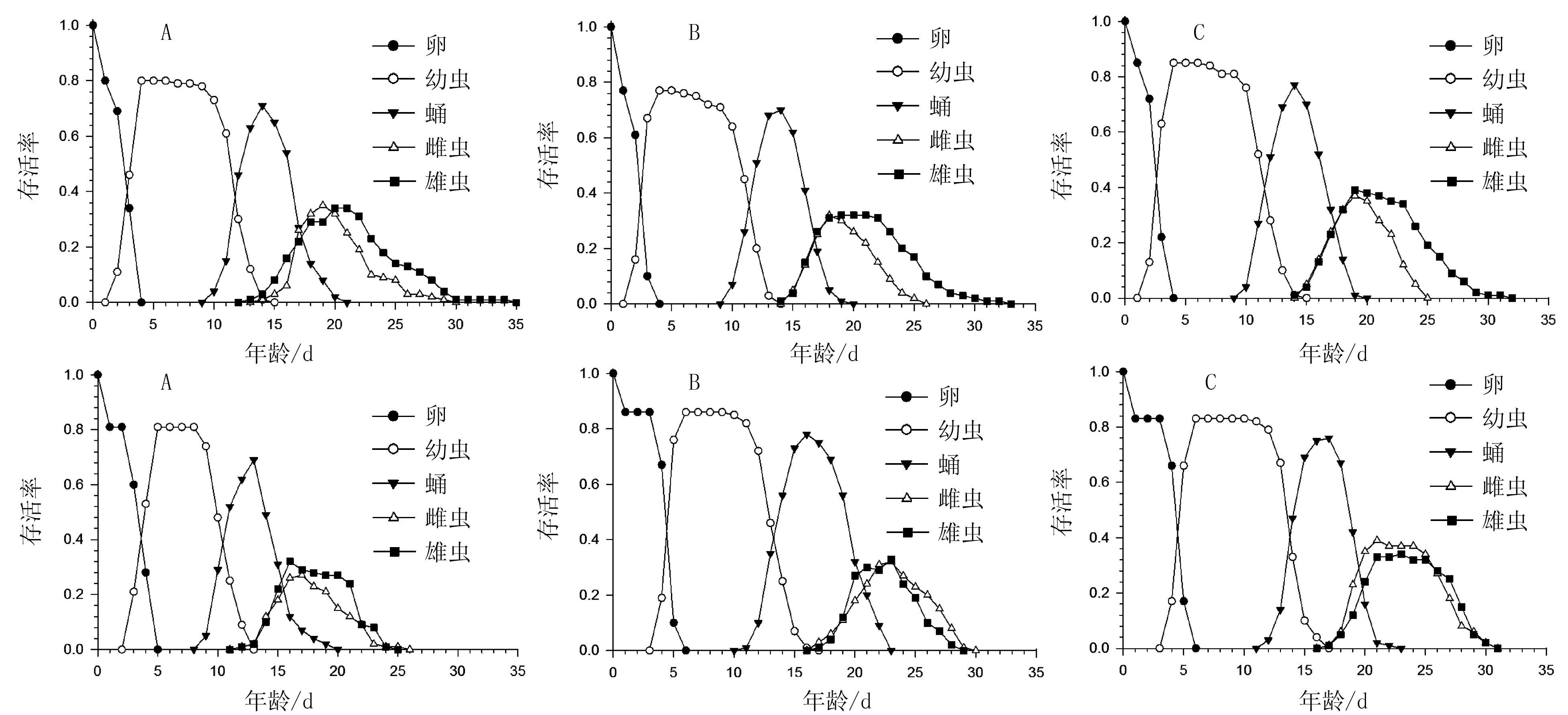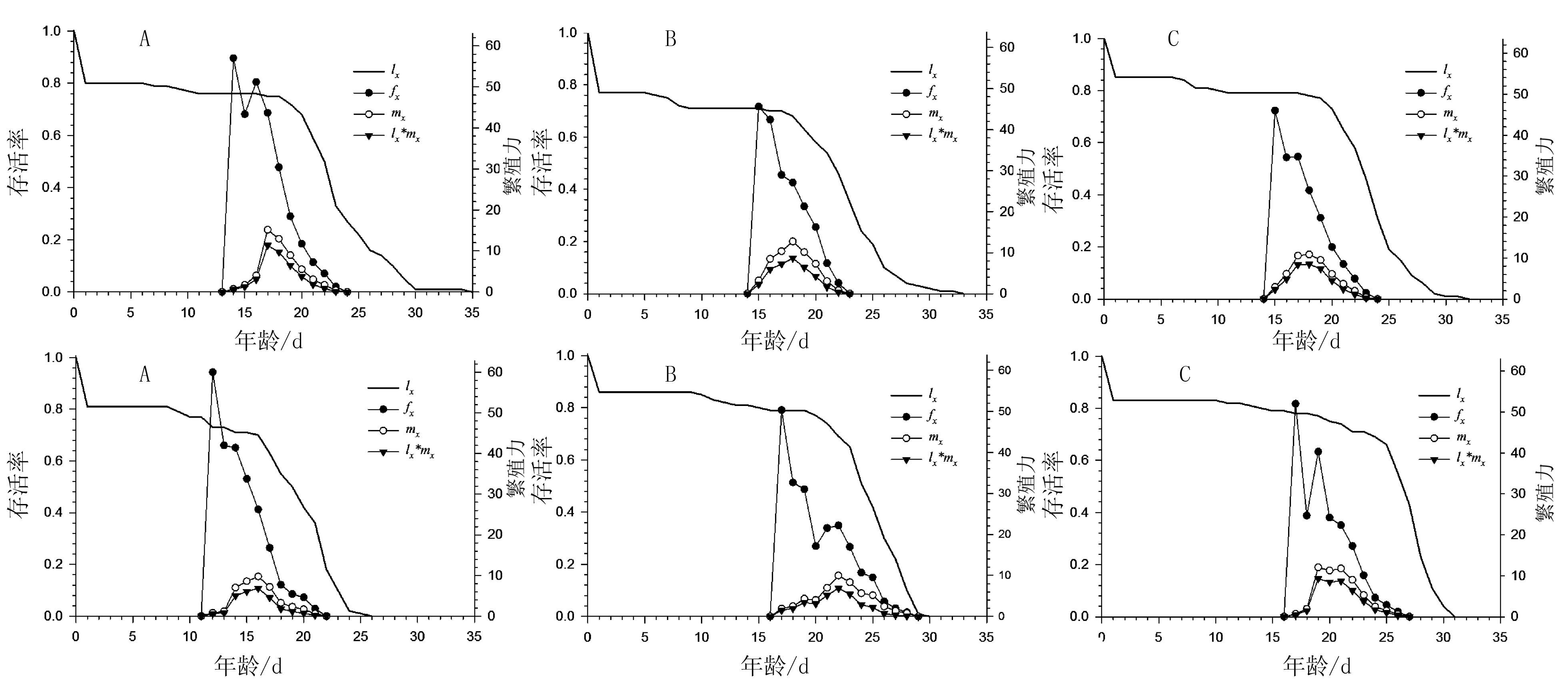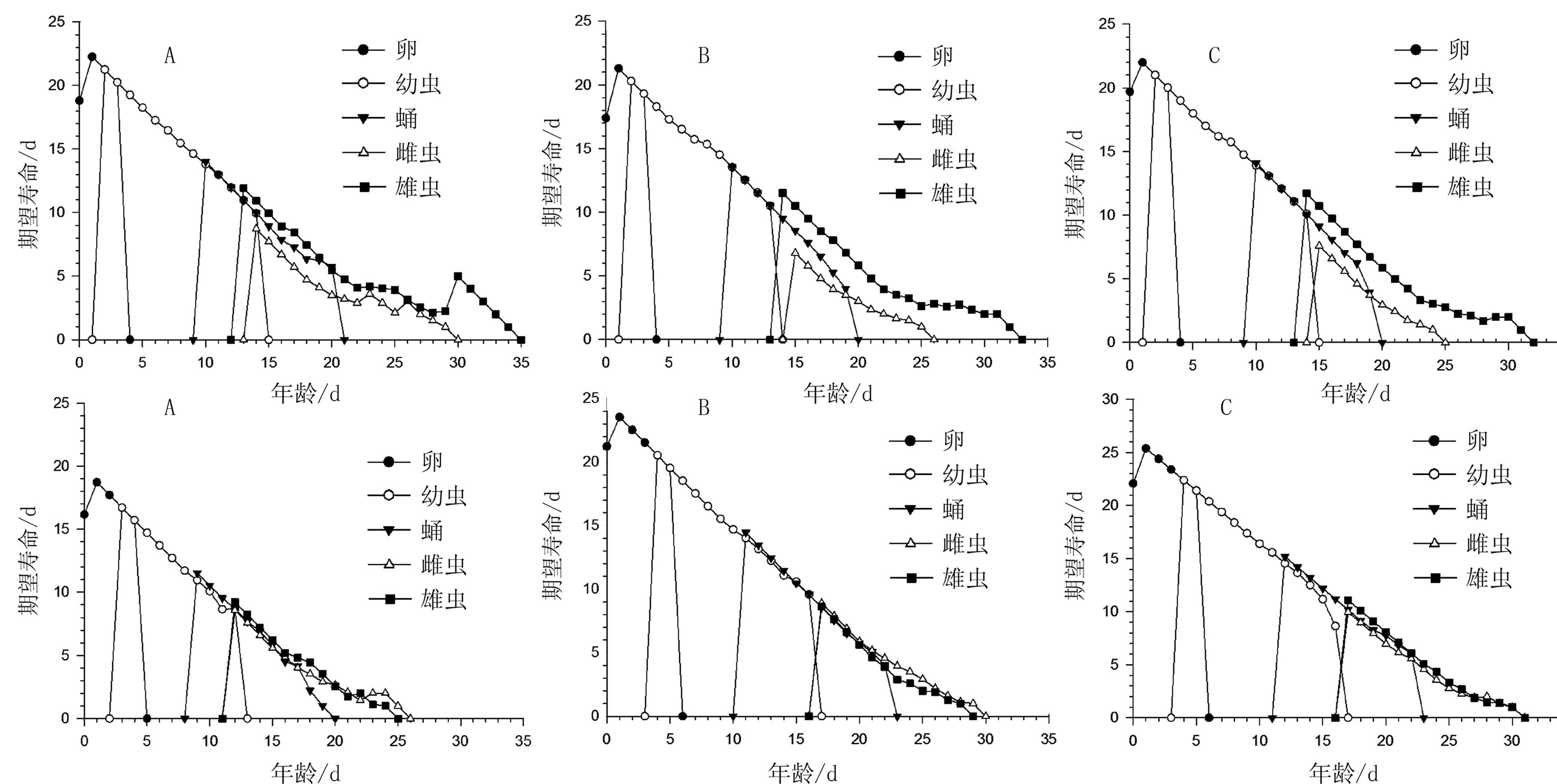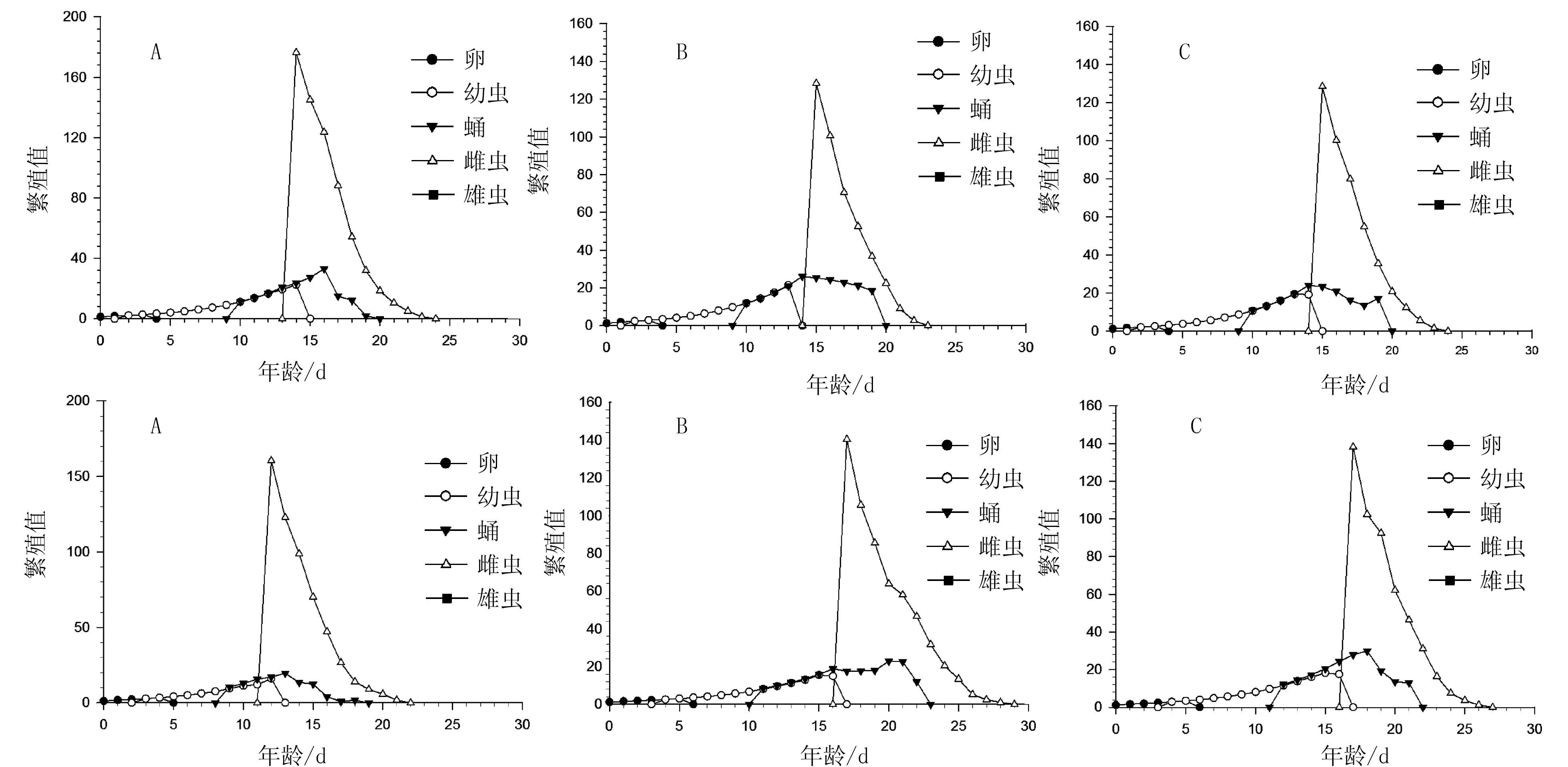Age-stage Two-sex Life Tables of Plutella xylostella (Lepidoptera:Plutellidae) under Hypoxia Stress
-
摘要: 为探明低氧胁迫对小菜蛾生长发育和种群动态参数的影响,为了解小菜蛾适应低氧环境提供相关的理论依据。在福建福州和西藏拉萨分别饲养福州品系的小菜蛾,将人工气候箱温度控制在(25±1)℃,空气相对湿度(65±5)%,光周期L:D=8:16。按照年龄-龄期两性生命表理论的统计方法记录原始数据,组建两性生命表,共记录3代。结果表明,通过分析两种氧环境下小菜蛾的生长发育历期、繁殖力和存活率等指标,以及相关的种群动态参数后发现,低氧环境对小菜蛾的发育历期有显著的影响:与在福州饲养的小菜蛾相比,在拉萨饲养的小菜蛾整体发育历期显著变短;但随着世代的增加在拉萨饲养的小菜蛾发育历期逐渐变长,到第3代的时候在拉萨饲养的小菜蛾的整体发育历期显著长于在福州饲养的小菜蛾,但生殖力无显著性差异。两种不同氧含量环境下小菜蛾的种群动态参数存在显著差异,在拉萨饲养的小菜蛾的r、λ、R0、T随世代增加逐渐增加,且第一代的r、λ、R0、T都显著低于第2代或第3代。说明在低氧环境下,小菜蛾在经过一代至二代的快速适应后提高了对低氧的耐受性,但是整体发育历期显著缩短,存在一定的适合度代价;当世代发展到第3代时,在2种含氧量环境下小菜蛾的生殖力、存活率及种群动态参数r、λ、R0、T都无显著性差异,说明小菜蛾有很强的适应能力,小菜蛾可以在比较短的时间适应青藏高原的低氧环境,低氧并不能成为阻止小菜蛾向高原扩散的障碍。Abstract: To understand the effects of hypoxia stress on growth, development and population dynamics of Plutella xylostella, and reveal relevant mechanisms underlying the hypoxic adaptation.We raised P. xylostella strain Fuzhou-S in greenhouses in Fuzhou and Lhasa, respectively. The temperature, air relative humidity and photoperiod of both greenhouses were (25±1)℃, (65±5)% RH and 8L:16D. Growth and development data in both locations with consecutive three generations were recorded. We then constructed age-stage, two-sex life tables of Fuzhou-S in Fuzhou and Lhasa.Compared with the DBM raised in Fuzhou, the results showed the hypoxic environment can shorten developmental periods of all instars (egg, larva, pupa and adult). Significant reduction of duration in the first generation was observed, while the difference decreased along with the time. Fecundity and survival rate did not change significantly. There were significant differences in the population dynamics of Fuzhou-S raised in Lhasa and Fuzhou. Intrinsic rate of increase (r), finite rate of increase (λ) and net reproductive rate (R0) were significantly lower, but mean generation time (T) was significantly lower in the first generation and significantly increased in the second generation.P. xylostella showed its tolerance to hypoxia within first two generations, where fitness cost was found by showing significant shortening developmental duration. In the third generation, fecundity, survival rate and relative population dynamics parameters r, λ, R0, T didn't show much difference between Fuzhou-S raised in two locations. We propose fast adaptation of P. xylostella to hypoxia may facilitate its rapid spread and colonization onto the plateau. Further analysis based on the molecular data could help untangling mechanisms underlying its adaption.
-
Key words:
- Plutella xylostella /
- hypoxia condition /
- adaptation /
- life table
-
表 1 低氧环境和常氧环境下福州品系小菜蛾不同发育阶段的历期
Table 1. Duration of different developmental stages of P. xylostella at different oxygen environment from Fuzhou
发育阶段 代数 低氧环境发育历期/d 常氧环境发育历期/d 数目 平均数±标准误 数目 平均数±标准误 卵 F1 81 4.09±0.09 b 80 3.29±0.08 a* F2 86 4.90±0.06 a 77 3.42±0.07 a* F3 83 5.00±0.07 a 85 3.11±0.07 a* 幼虫 F1 74 6.92±0.10 c 76 9.00±0.10 a* F2 80 8.94±0.13 b 71 8.93±0.09 a F3 78 9.31±0.10 a 79 9.00±0.09 a* 蛹 F1 66 4.21±0.10 c 76 4.86±0.11 b * F2 73 6.44±0.12 a 70 4.94±0.08 b* F3 75 5.28±0.11 b 78 5.01±0.08 a 成虫前期 F1 66 15.15±0.16 c 76 17.17±0.19 a* F2 73 20.23±0.19 a 70 16.80±0.14 a* F3 75 19.61±0.13 b 78 17.12±0.15 a* 雌虫 F1 30 5.67±0.29 b 39 5.51±0.39 a* F2 38 5.76±0.21 b 37 4.97±0.29 a* F3 41 7.56±0.33 a 39 5.51±0.19 a* 雄虫 F1 36 6.11±0.29 b 37 8.19±0.49 a* F2 35 5.66±0.19 c 33 8.94±0.43 a* F3 34 8.26±0.22 a 39 8.59±0.37 a* 产卵前期 F1 29 0.07±0.05 a 39 0.08±0.04 a* F2 37 0.16±0.08 a 36 0.06±0.04 a F3 39 0.18±0.07 a 39 0.00±0.00 a* 总产卵前期 F1 29 15.10±0.26 c 39 17.36±0.21 a* F2 37 20.62±0.32 a 36 17.00±0.22 a* F3 39 19.59±0.19 b 39 17.10±0.22 a* 生殖力 F1 30 83.23±5.11 c 39 100.05±3.10 a* F2 38 88.47±3.83 b 37 99.30±4.54 a* F3 41 101.34±4.76 a 39 101.08±2.66 a 最大产卵量 F1 151 139 F2 119 154 F3 141 132 寿命 F1 100 16.16±0.82 b 100 18.80±0.98 a* F2 100 21.23±0.91 a 100 17.40±1.01 a* F3 100 22.08±1.03 a 100 19.70±0.90 a 注:同列数据后不同字母表示相同处理不同代数间有显著性差异 (P<0.05),*表示不同处理相同代数间有显著性差异 (P<0.05)。 表 2 常氧环境和低氧环境下福州品系小菜蛾的种群动态参数 (平均值±标准误)
Table 2. Population parameters (means ± S.E.) of P. xylostella in different oxygen environment from Fuzhou
环境 代数 内禀增长率/d-1
r周限增长率/d-1
λ净增值率
R0平均世代时间/d
T常氧环境 F1 0.195±0.008 a* 1.215±0.009 a* 39.044±5.027 a* 18.760±0.222 a* F2 0.193±0.008 a* 1.213±0.010 a* 36.725±5.063 a* 18.632±0.219 a* F3 0.195±0.007 a 1.215±0.009 a* 39.425±5.043 a 18.823±0.216 a 低氧环境 F1 0.140±0.011 b 1.161±0.013 b 27.667±4.493 c 16.529±0.267 b F2 0.158±0.007 a 1.171±0.008 a 33.645±4.540 b 22.184±0.355 a F3 0.173±0.006 a 1.188±0.007 a 41.543±5.329 a 21.537±0.187 a 注:同列数据后不同字母表示相同处理不同代数间有显著性差异 (P<0.05),*表示不同处理同代数间有显著差异 (P<0.05)。 -
[1] SARFRAZ M, KEDDIE A B, DOSDALL L M. Biological control of the diamondback moth, Plutella xylostella: A review[J]. Biocontrol Science and Technology, 2005, 15(8): 763-789. doi: 10.1080/09583150500136956 [2] TALEKAR N, SHELTON A. Biology, ecology, and management of the diamondback moth[J]. Annual review of entomology, 1993, 38: 275-301. doi: 10.1146/annurev.en.38.010193.001423 [3] 吴青君, 张文吉.小菜蛾的发生为害特点及抗药性现状[J].中国蔬菜, 2001, (5): 49-51. http://www.cnki.com.cn/Article/CJFDTOTAL-ZGSC200105027.htm [4] VERKERK R H, WRIGHT D J. Multitrophic interactions and management of the diamondback moth: a review[J]. Bulletin of Entomological Research, 1996, 86(3): 205-216. doi: 10.1017/S0007485300052482 [5] FURLONG M J, WRIGHT D J, DOSDALL L M. Diamondback moth ecology and management: problems, progress, and prospects[J]. Annual Review of Entomology, 2013, 58: 517-541. doi: 10.1146/annurev-ento-120811-153605 [6] 安克杰, 许进鸿, 李梦寒, 等.西藏野生油菜与栽培油菜遗传资源比较分析[J].种子, 2016, (3): 55-58. http://www.cnki.com.cn/Article/CJFDTOTAL-ZHZI201603015.htm [7] 袁玉婷.西藏油菜产业化发展浅析 (上)[J].西藏农业科技, 2016, 38 (1): 1-8. http://www.cnki.com.cn/Article/CJFDTOTAL-XZNY201601002.htm [8] 赵彩霞.西藏引种油菜新品种适应性种植研究[J].西藏农业科技, 2015, 37 (3): 20-26. http://www.cnki.com.cn/Article/CJFDTOTAL-XZNY201503006.htm [9] 胡胜昌.西藏油菜和十字花科蔬菜主要害虫发生简况[J].植物保护学报, 1988, 14: 38-39. http://www.cnki.com.cn/Article/CJFDTOTAL-ZWBH198806024.htm [10] TUAN S J, LEE C C, CHI H. Population and damage projection of Spodoptera litura (F.) on peanuts (Arachis hypogaea L.) under different conditions using the age-stage, two-sex life table[J]. Pest Management Science, 2014, 70 (5): 805-813. doi: 10.1002/ps.2014.70.issue-5 [11] KAVOUSI A, CHI H, TALEBI K, et al. Demographic traits of Tetranychus urticae (Acari: Tetranychidae) on leaf discs and whole leaves[J]. Journal of Economic Entomology, 2009, 102 (2): 595-601. doi: 10.1603/029.102.0217 [12] HUANG Y B, CHI H. Age-stage, two-sex life tables of Bactrocera cucurbitae (Coquillett) (Diptera: Tephritidae) with a discussion on the problem of applying female age-specific life tables to insect populations[J]. Insect Science, 2012, 19 (2): 263-273. doi: 10.1111/j.1744-7917.2011.01424.x [13] CHI H, SU H Y. Age-stage, two-sex life tables of Aphidius gifuensis (Ashmead) (Hymenoptera: Braconidae) and its host Myzus persicae (Sulzer) (Homoptera: Aphididae) with mathematical proof of the relationship between female fecundity and the net reproductive rate[J]. Environmental Entomology, 2006, 35 (1): 10-21. doi: 10.1603/0046-225X-35.1.10 [14] YU Y L, HUANG L J, WANG L P, et al. The combined effects of temperature and insecticide on the fecundity of adult males and adult females of the brown planthopper Nilaparvata lugens St l (Hemiptera: Delphacidae)[J]. Crop Protection, 2012, 34: 59-64. doi: 10.1016/j.cropro.2011.08.026 [15] CHI H. Life-Table Analysis incorporating both sexes and variable development rates among individuals[J]. Environmental Entomology, 1988, 17 (1): 26-34. doi: 10.1093/ee/17.1.26 [16] DUNNETT C W. Pairwise multiple comparisons in the homogeneous variance, unequal sample size case[J]. Journal of the American Statistical Association, 1980, 75 (372): 789-789. doi: 10.1080/01621459.1980.10477551 [17] GABRE R M, ADHAM F K, CHI H. Life table of Chrysomya megacephala (Fabricius)(Diptera: Calliphoridae)[J]. Acta oecologica, 2005, 27 (3): 179-183. doi: 10.1016/j.actao.2004.12.002 [18] RINEHART J P, YOCUM G D, DENLINGER D L. Thermotolerance and rapid cold hardening ameliorate the negative effects of brief exposures to high or low temperatures on fecundity in the flesh fly, Sarcophaga crassipalpis[J]. Physiological Entomology, 2000, 25 (4): 330-336. doi: 10.1046/j.1365-3032.2000.00201.x [19] HEINRICH E C, FARZIN M, KLOK C J, et al. The effect of developmental stage on the sensitivity of cell and body size to hypoxia in Drosophila melanogaster[J]. Journal of Experimental Biology, 2011, 214 (9): 1419-1427. doi: 10.1242/jeb.051904 [20] CALLIER V, HAND S C, CAMPBELL J B, et al. Developmental changes in hypoxic exposure and responses to anoxia in Drosophila melanogaster[J]. Journal of Experimental Biology, 2015, 218 (18): 2927-2934. doi: 10.1242/jeb.125849 [21] CHENG W, LEI J, AHN J E et al. Effects of decreased O2 and elevated CO2on survival, development, and gene expression in cowpea bruchids[J]. Journal of Insect Physiology, 2012, 58 (6): 792-800. doi: 10.1016/j.jinsphys.2012.02.005 [22] GARRAD R, BOOTH D T, FURLONG M J. The effect of rearing temperature on development, body size, energetics and fecundity of the diamondback moth[J]. Bulletin of Entomological Research, 2016, 106 (2): 175-181. doi: 10.1017/S000748531500098X -








 下载:
下载:




